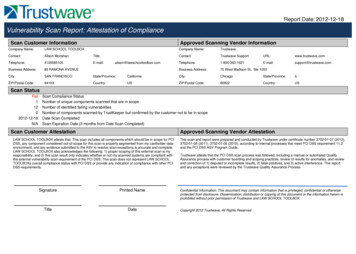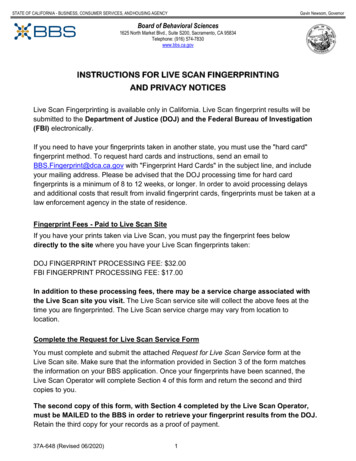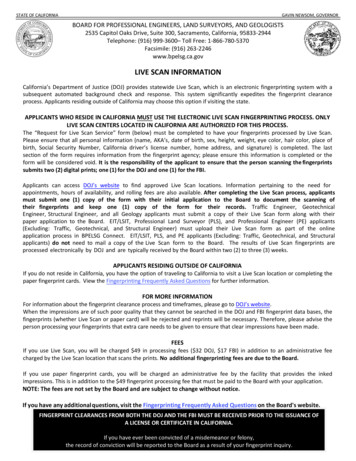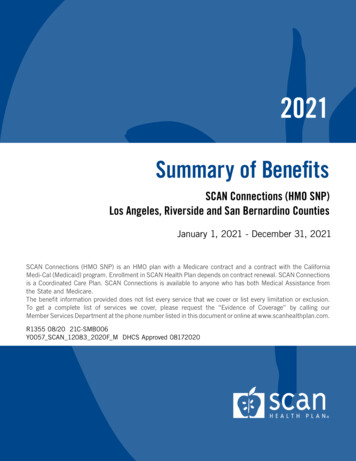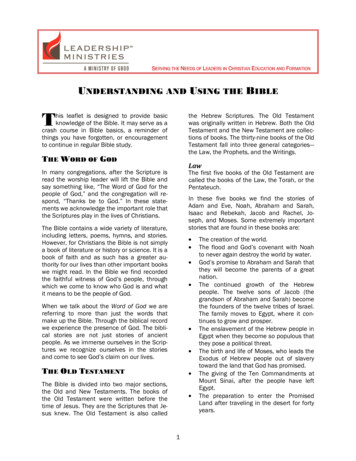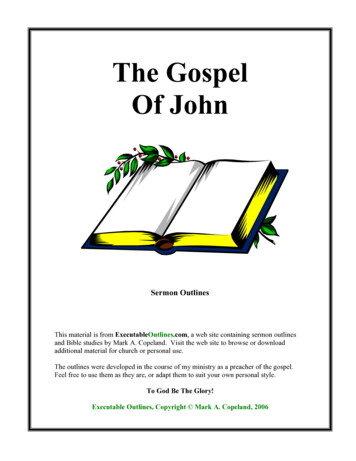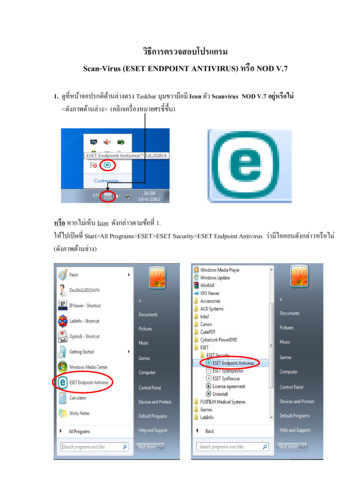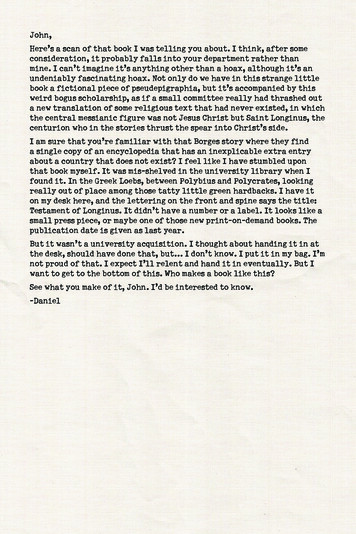
Transcription
John,Here’s a scan of that book I was telling you about. I think, after someconsideration, it probably falls into your department rather thanmine. I can’t imagine it’s anything other than a hoax, although it’s anundeniably fascinating hoax. Not only do we have in this strange littlebook a fictional piece of pseudepigraphia, but it’s accompanied by thisweird bogus scholarship, as if a small committee really had thrashed outa new translation of some religious text that had never existed, in whichthe central messianic figure was not Jesus Christ but Saint Longinus, thecenturion who in the stories thrust the spear into Christ’s side.I am sure that you’re familiar with that Borges story where they finda single copy of an encyclopedia that has an inexplicable extra entryabout a country that does not exist? I feel like I have stumbled uponthat book myself. It was mis-shelved in the university library when Ifound it. In the Greek Loebs, between Polybius and Polycrates, lookingreally out of place among those tatty little green hardbacks. I have iton my desk here, and the lettering on the front and spine says the title:Testament of Longinus. It didn’t have a number or a label. It looks like asmall press piece, or maybe one of those new print-on-demand books. Thepublication date is given as last year.But it wasn’t a university acquisition. I thought about handing it in atthe desk, should have done that, but. I don’t know. I put it in my bag. I’mnot proud of that. I expect I’ll relent and hand it in eventually. But Iwant to get to the bottom of this. Who makes a book like this?See what you make of it, John. I’d be interested to know.-Daniel
,nhoJemos retfa ,kniht I .tuoba uoy gnillet saw I koob taht fo nacs a s’ereHnaht rehtar tnemtraped ruoy otni sllaf ylbaborp ti ,noitaredisnocna s’ti hguohtla ,xaoh a naht rehto gnihtyna s’ti enigami t’nac I .enimelttil egnarts siht ni evah ew od ylno toN .xaoh gnitanicsaf ylbainednusiht yb deinapmocca s’ti tub ,aihpargipeduesp fo eceip lanoitcif a koobtuo dehsarht dah yllaer eettimmoc llams a fi sa ,pihsralohcs sugob driewhcihw ni ,detsixe reven dah taht txet suoigiler emos fo noitalsnart wen aeht ,sunignoL tniaS tub tsirhC suseJ ton saw erugif cinaissem lartnec eht.edis s’tsirhC otni raeps eht tsurht seirots eht ni ohw noirutnecdnif yeht erehw yrots segroB taht htiw railimaf er’uoy taht erus ma Iyrtne artxe elbacilpxeni na sah taht aidepolcycne na fo ypoc elgnis anopu delbmuts evah I ekil leef I ?tsixe ton seod taht yrtnuoc a tuobaI nehw yrarbil ytisrevinu eht ni devlehs-sim saw tI .flesym koob tahtgnikool ,setarcyloP dna suibyloP neewteb ,sbeoL keerG eht nI .ti dnuofti evah I .skcabdrah neerg elttil yttat esoht gnoma ecalp fo tuo yllaer:eltit eht syas enips dna tnorf eht no gnirettel eht dna ,ereh ksed ym noa ekil skool tI .lebal a ro rebmun a evah t’ndid tI .sunignoL fo tnematseTehT .skoob dnamed-no-tnirp wen esoht fo eno ebyam ro ,eceip sserp llams.raey tsal sa nevig si etad noitacilbupta ni ti gnidnah tuoba thguoht I .noitisiuqca ytisrevinu a t’nsaw ti tuBm’I .gab ym ni ti tup I .wonk t’nod I .tub ,taht enod evah dluohs ,ksed ehtI tuB .yllautneve ni ti dnah dna tneler ll’I tcepxe I .taht fo duorp ton?siht ekil koob a sekam ohW .siht fo mottob eht ot teg ot tnaw.wonk ot detseretni eb d’I .nhoJ ,ti fo ekam uoy tahw eeSleinaD-
TheTESTAMENTofLONGINUSA Revised Translation of the text from the Latin and Greekcontaining the Rule of Golgotha, the Sanguinaria and the EschatonEdited by committeeSPLDAtlanta Reykjavik Shanghai LondonMMVIII
Published ByWhitE Wolf PUBLISHING2075 West Park Place Blvd, Suite GStone Mountain, GA 30087Senior ContributorsHOWARD INGHAM, GENEVIEVE PODLESKIEditorEDDY WEBBBook DesignCRAIG S GRANT 2009 CCP hf. All rights reserved. Reproduction without the written permissionof the publisher is expressly forbidden, except for the purposes of reviews, and oneprinted copy which may be reproduced for personal use only. White Wolf, Vampire and World of Darkness are registered trademarks of CCP hf. All rights reserved.Vampire the Requiem, Werewolf the Forsaken, Mage the Awakening, Prometheanthe Created, Changeling the Lost, Hunter the Vigil, Storytelling System and ParlorGames are trademarks of CCP hf.All rights reserved. All characters, names, places and text herein are copyrighted byCCP hf.CCP North America Inc. is a wholly owned subsidiary of CCP hf.The mention of or reference to any company or product in these pages is not a challenge to the trademark or copyright concerned. This book uses the supernatural forsettings, characters and themes. All mystical and supernatural elements are fictionand intended for entertainment purposes only. This book contains mature content.Reader discretion is advised.Check out White Wolf online at http://www.white-wolf.comii
v1Preface to the Revised EditionTHE TESTAMENT OF LONGINUS,with notes and alternate readings1132139455365The MaledictionThe Torments of LonginusThe Rule of GolgothaThe First Book of SanguinariaThe Second Book of SanguinariaThe Book of the EschatonAPPENDICES65Appendix I:Textual History of the Testament of Longinus69Appendix II:Fragments from the Longinian Apocrypha75Appendix III:The Search for the Historical Longinusiii
Preface to theRevised EditionIt seems something of an oversight that the central text on which the religionof Longinus rests should not have been given a translation that reflects modern innovations in scholarship and recent manuscript discoveries (not leastthe vitally important fragments uncovered at the Oxyrhynchus site and in theNag Hammadi codices).The original Authorized Version of the Testament of Longinus was a tremendous achievement for the scholars translating it and for the faithful adherentsof the Longinian Rule who had long sought a vernacular translation. We existin its shadow; we cannot hope to duplicate the dignity and power of its prose,much of which has passed from the page into common usage. It transformedour language. It transformed the way we think of ourselves.But the language of the old version, for all its force and grace, is now asarchaic and inaccessible to the new reader or listener as the Vulgate Testamentwas four hundred years ago. It is time for a version of the Testament that reflects the times we inhabit.In early 2004, a committee of Archbishops and other significant figuresmet in London at the instigation of the Rt. Rev. Francis Rose to discuss thepossibility of a new edition of the Testament. Although some controversy inevitably resulted, Archbishop Rose’s party held the day, and a committee ofthree scholars was invited to begin the project: myself, Caroline Petronius ofChicago and Victor Ballsden of London.The result of these deliberations is the present volume.This edition of the Testament of Longinus of course includes the five booksof the generally accepted Longinian canon. We can assume that little introduction need be made of these books to the devotee, but since we intend thiswork to be accessible to a wider scholarly audience, it serves our purposes tooffer some explanation.The Malediction of Longinus concerns the life of Longinus, largely beforethe epochal events on Calvary, and presents Longinus the man as a barely repentant sinner. The Torments of Longinus begins where the Malediction leavesoff. Torments (sometimes The Book of Torments) was once generally considereda second part of the same document as the Malediction, but stylistic and linguistic differences, as well as differing MS traditions, lead us to at least enter-v
tain the possibility that they are by two different authors. We do not commenton the possible truth of this theory; we shall offer the evidence to the readerand arguments from both single-author and multiple-author positions.If this is indeed true, then the Rule of Golgotha is by the latter of the twoLonginian Authors. The Rule has traditionally been a short text, but a longerversion has recently been unearthed – that version has been provided in thisedition. Regardless, the Rule has been the most influential book on our politicaldevelopment, it being a collection of teachings and laws. The Sanguinaria (heredivided into two sections, as per the Authorized Version) concerns the acts andfates of Longinus’ disciples. It is largely thought to comprise two texts, but thesetexts are not divided equally among the two halves of the book. Finally, theBook of the Eschaton falls firmly into the genre of the apocalyptic.Some more detailed notes on the transmission and theories as to multipleauthorship of these texts (along with speculation on the possible identities of theputative Deutero-Longinus and Trito-Longinus) can be found in Appendix I.We follow the main body of the Testament with a summary and selectionof texts from the Longinian apocrypha, which, while not generally acceptedas doctrine by most orthodox divines, are nonetheless well known and oftencommonly referenced (although some are given more credence than others).The apocryphal books are: the anonymous Testimony of the Plague Angel, theTeachings of Longinus, the Byzantine Tradition of Blood and the Acts of Daniel.We have also included a few surviving fragments from the heretical Euagaematikon of Vitericus Minor, for the sake of interest. We include these textswith no comment as to their value, historical or doctrinal; only the hope thatthey may illuminate the context of the canonical Testament for the casualreader and the devotee, and to offer a starting point for the more scholarlyreader. These can be found in Appendix II.We should add a word or two on Longinus himself. In our history, noone figure (with the possible exception of a late-medieval Eastern European,of whom this is not the place to speak) has caused so much controversy, orhas directed political and social change so drastically and so many times asLonginus. We recognize that any pronouncement made on a figure who formsthe basis of religious faith should be made with care or controversy will result,and hence we step lightly. Longinus is by tradition and consensus the protagonist, narrator and author of the short collection of books that bear his name,and the Testament is the most complete source for Longinus’ life and career.However, we would be remiss not to mention that the earliest textual mentionof Longinus occurs not in the Testament itself, but outside of the LonginianTradition, in the Gospel of Nicodemus (also known as the Acts of Pilate). Hismention amounts wholly to the following:But Jesus spake before Pilate, and we know that we saw him receive buffets andspittings upon his face, and that the soldiers put on him a crown of thorns and thathe was scourged and received condemnation from Pilate, and that he was crucifiedat the place of a skull and two thieves with him, and that they gave him vinegar todrink with gall, and that Longinus the soldier pierced his side with a spear.(Gospel of Nicodemus XVI. 7, trans. MR James)viPreface
This text dates to the early fourth century CE, only shortly before theTestament’s accepted date of writing. He is from the very beginning the bearer of the Lance that pierced the side of Christ. In fact, some commentatorspoint out the similarity between the name “Longinus” and the Greek λογχη(longche, “spear”), suggesting that the name ascribed to him is nothing morethan a corruption of “the spearman.”Tradition would later hold that he converted to Christianity and was martyred. Longinus’ story flourished through the Middle Ages, although transmission outside of the ranks of the Longinian faithful proved garbled. A version of Longinus’ story was accepted by the living Catholic Church for centuries; the most commonly referenced retelling appears in Jacob de Voragine’sGolden Legend:Longinus, who was a powerful knight, was by the side of the cross of our Lordwith other knights, by the command of Pilate. He pierced the side of our Lord witha spear. When he saw the miracles, how the sun lost his light, and the earthquakewhen our Lord suffered death and passion on the tree of the cross, he believed inJesus Christ. Some say that when he struck our Lord with the spear in the side, theprecious blood ran down the shaft of the spear and onto his hands, and by chance,he touched his eyes with his hands. And before he was blind, and now he could see.He gave up arms, and went to stay with the apostles.(de Voragine, Life of Saint Longinus, translation my own)The Golden Legend goes on to tell us that Longinus lives as a monk until theEmperor Octavian calls him to account and has Longinus beheaded. The Emperor converts to Christianity over Longinus’ headless body. One need not be muchof an historian to understand this to be a fiction, but it deserves mention becauseit demonstrates that the tale of Longinus had passed—although in admittedlygarbled form—outside of our own circles and into wider living society. Had thestory been overheard? (We address the history of the tale of Longinus and talk oftheories surrounding the person behind the religion in Appendix III.)Whatever we might conclude from the tale of the Curse of Longinus, wecannot deny that the story of Longinus is not a secret story, although somewould hide it. But neither is it an open story. It requires study. It requiresrespect. It has resonance for us all, and even if we do not believe in its literaltruth—or in some cases, in any truth it might hold at all—we must acceptthat it is one of the most powerful collections of texts ever written. In its pageshave been found the pretexts for the greatest advancements and innovations ofour society, and the worst injustices. To some it is the final source of wisdom,freedom, survival. To others it is an evil book, the source of all oppression.No matter what viewpoint you hold, the fact remains that the Testament ofLonginus cannot be ignored.It is our history.Henry Matthews, Director of Translations, SPLD New York,Editor of the Revised EditionPrefacevii
The Maledictionof Longinus1I am God's holy monster. I drink from humanity.2I could not see what part I would play for such a long time, because I lookedat it with human eyes, with eyes that would die.a3So I put forth the truth in this book, for you who seek, just as I have sought.4For I am not some Godless beast who hunts beneath the grandeur of sanctity.5I am the grandeur; 6I am sanctified.b7This is who I am: I am the bearer of the Spear that pierced the side of Jesus Christof Nazareth, Son of David, Begotten Son of God, who died at my hand anddescended to Hell and bruised the head of Satan, who rose from the dead onthe third day 8that he might save the living. 9But He cannot save the dead.10I was born on the same day as Christ, and I died on the same day. Christ wasthe son of a virgin; I was the son of a whore.Christ taught others to treat others as they would be treated; I only soughtto gain what I could, and took what I wanted, and killed whom I wanted.12Christ was a man of peace who never raised his hand against another manc; I was a man who took pay for the deaths and pains of others.13Christ lived in righteousness; I lived in sin.1114In my life, from the age of twelve, when I came into my true nature, I indulged in every sin. I gave in to anger, and beat men to death with mybare hands. 15I placed myself above man and God and would not allowany man to subdue me. 16I slaked my lusts upon women and boys andmen and beasts, and sometimes they were willing, and sometimes I paidfor unclean pleasures with gold and silver and sometimes I did not, andsometimes they were not willing and I raped them. 17I envied the condition of my fellow men, for I was born poor, and this led me to murderand to steal. 18And I hoarded the gold I stole from the men whose homesI robbed and the gold I took from the people whose taxes I collected. 19Igave in to strong drink, and I made myself sick with the food I ate.aLit. “mortal”; alternately, with the eyes of a mortal. VBbThis initial passage (Mal. 1:1-6) was originally written in verse. VBcThe author is mistaken in this respect, if John 2:13-15 is to be believed. CP1
202For every good deed that Christ performed, I performed an evil deed. For every miracle and sign that Christ revealed upon the Earth, I made a tragedycome to occur. For each innocent whom Christ healed, I brought pain to aninnocent, or I killed, or I maimed. 21It was the perfect will of God that mylife be in every way the mirror of Christ; it was God’s perfect and pleasingwill that I be present at Christ’s death, and that my hand should wield myspear, and that I should deal the blow that slew him. 22And that I should becursed. For God predestined me to be cursed. And this is my fate.dMy name is Longinus; I have no other. 2I am a Roman, and I was born in thecity of Rome to a whore; and her name was Livia. I do not know who myfather was; my mother saw no wrong that in her sin — sin that led manymen to ruin and debaucherye — she conceived me; and that she did knowthe name of the man that conceived me.3But in a dream one night, a dark man came to her and told her that he hadmade her pregnant with me and had paid her one denarius for the pleasure. I had the mark of God upon me, said the man, and I would be acurse upon the Earth and a vessel of God’s wrath upon the guilty and atest to the innocent, and yet she was not to harm me when I was born, forGod had marked me out to bring wrath upon the Earth and bring judgment upon it. 4The dark man told me that I should be called Longinus; shedisobeyed him and gave me another name, that I shall not name.fMy mother’s home city was Nola. Her parents were still living, and she waseleven years old when she rejected their love and care and traveled toRome. 6There, she lost her virginity as soon as she could, in whatever wayshe could; she threw herself into the slavery of lust. 7She taught me thethings she knew, and encouraged me in her undying passion for her sinand her love of debauchery. 8From the age of fourteen, she sold herself tothe public, and she sold herself cheaply, for she took pleasure in the evilsshe performed.g 9At times, she was so enamored of the carnal evils sheperformed that she asked no price, and thought not of the consequencesof her sin. 10I was made by her to beg and pick pockets as soon as I couldwalk, so that we might not starve.5d Much like how Genesis lays out the creation story in the first chapter and then beginsagain in the second and third chapters with slightly different specifics, so the text here tellsthe whole of Longinus’ story almost in précis, and then begins again in more detail in thesecond chapter. There is reason to assume that this first chapter is in fact either a later addition or an entirely separate document — part of the original catechism, perhaps — thatsomehow got included in the tradition and eventually incorporated into the text. CPe Biblical criticism has for several years engaged with feminist thinking (see for examplePhyllis Trible, Texts of Terror, Minneapolis 1984); feminist expositions of the Testament,however, are perhaps unsurprisingly few and far between. A feminist critique of Longinus’interactions and relationship with his prostitute mother is sorely needed. CPfDebate among orthodox Monachal circles concerning the identity of the Dark Manhas been fierce. Conservatives generally conclude that it was a visitation from Satan, their(convincing) logic depending upon the parallelism of Livia with Mary: Mary was a virgin,Livia was anything but; Mary was impregnated by the Holy Spirit, Livia’s impregnation waswholly carnal; Gabriel visited Mary, and Satan — who is, remember, an archangel, andhence equal with Gabriel — visited Livia. And of course, Mary obeys Gabriel with regard toher child’s name, while Livia does not. VBg Engaging in pleasure in the carnal act was seen by both pagans and Christians as afundamentally sinful characteristic in a woman. CP2Malediction 1:20
I became known to the men and women and dogs of the streets of Rome asthe Bastard, for even then, knowing that I would be more, I refused to usethe name that had been given to me, and on the day that I reached the ageof twelve, my mother too ceased to use the name she had given, and she toowould only call me the Bastard. 12It was when I was twelve years of age, too,that I chose to steal my mother’s meager earnings and place a wager on theresult of a chariot race in the Circus. It happened that the chariot on whichI placed my mother’s money lost its wheel, and the charioteer was thrownto the earth and trampled to death under the horses of another driver. 13Ilost the money, and when I returned home, my mother scolded me andtook out a whip and meant to beat me; 14but even though I was a boy I wasstronger than her, for she was slight, and I had strangled dogs with my barehands and taken them home for meat. 15And I snatched the whip from mymother’s hand and stripped her dress from her and whipped her into thestreet naked, and as I pursued her into the street and whipped her bloodyand seized her hair and dragged her into the forum, 16I cried out loud tothe assembled scum of Rome: “She is a dog, fit only for mounting!” 17AndI offered her body to the men who would take her, and took the money formy own earnings as the men of the city took their pleasure upon her, for mywords were powerful and persuaded men to follow their desires.1118And from that day on, I was master of my house, and I held the purse, andI beat my mother if she did not hand the gold to me to use as I would,and I bought her fine dresses and oils for her hair, and paint for her face,and I fed her as I would, but she was my slave, and she would not speakout against me.And I grew to manhood, and became fond of wine. I drew companions tome, and they numbered twelve, 20and they were Veranius the seller ofknives, and Gellius the butcher; Malchio the usurer, Ascyltus and Gitonthe catamites, Gaius Clodius and Lucius Clodius the sons of Sextus;Philebus and Florens; Encolpia the whore; Plotius the lover of wine; andGanymede, whom I betrayed.1921And the Twelve stood beside me in all the crimes that I would commit.When I stole, they stole with me, and when I killed, they joined in theslaughter. And when I took a woman, they would hold her and silenceher, and throw her corpse into the river. 22A night came when I becamesoaked with wine, and came into my home, and seized my mother by thehair, and took my pleasure upon her.And I returned to the Twelve and boasted to them of what I had done, andsaid, “Am I not a more fortunate man than any of you? For who amongyou has had pleasure with a whore so beautiful as my ripe mother?”24And so I committed the sin of lust.323And I was known as a violent man. 2I would have no truck with any man whodisagreed with me, or thwarted me in my lust or greed or gluttony, 3and Ikilled whom I saw fit, and I fought with abandon. 4 A seller of vegetablesclaimed that I had taken his wares and that I had cheated him of his due,and I told Ganymede and the sons of Sextus Clodius to hold him down,Malediction 3:43
and I broke both of his arms, so that he could not dig his precious vegetables. 5And the son of Livia’s sister, who cheated me in a wager, his handI cut off so that he could not cheat me again, nor anyone else.6And so I committed the sin of anger. And my neighbors feared me, and theyhated me. And I was content.7It so happened that a certain centurion called Pandira h had entered into awager with me concerning the outcome of a dog fight and had won, forhis dog had torn out the throat of mine, and the blood had run across thestones of the forum. 8Now Pandira was a corrupt man and had cheatedme, but he had the swords of eighty men at his command and I had onlytwelve. 9But he claimed generosity and offered me a post as a soldier in hisgarrison, and I knew that I must become a soldier, and Ganymede and thesons of Sextus Clodius joined me in the arms and armor of the soldier.104And so it was that I and the Three traveled to the land of Judea, there to serveas soldiers of the Emperor of Rome.And in Judea, I saw that in my armor I was feared, and that I could take the goodsthat I wanted, and that I could take any woman that I wanted, and that whilecollecting the taxes I could add sums of my own, and I saw that it was good.And I saw that I could be rich. 2And so I committed the sin of greed.3But I saw that I was not a good soldier. 4For a centurion is a man set under authority, with soldiers under him. He says to a man “Come,” and the mancomes, and he says to another, “Go,” and the man goes, and to another“Do this,” and the man does it.i 5But when the centurion told me to come,I did not come, and when he told me to go, I did not go. And when he toldme to do a thing, I did not do it. And so I came to know the lash and therod, and the scars grew long and red on my back, and the blood ran freelyon the barracks floor. 6And I was made to clean out the buckets of waste,and to scrub the barracks floor. And I was humiliated. But Ganymede andthe sons of Sextus Clodius found that they took pleasure in the trainingand the order of the army, and grew in favor with the decurion and thecenturion. And when a stone cast by a Judean killed a centurion, Pandirachose from the men Ganymede and raised him up.And I grew envious of Ganymede, and I spoke to a brothel-keeper that weboth knew, and I caused the brothel-keeper to give to Ganymede a woman who hated the Romans, and arranged for her to be given a knife, andwhen Ganymede went into the woman’s room to take his pleasure withher, she thrust the dagger into Ganymede’s eye and Ganymede was dead.And I had done this for no other reason that Ganymede had been raisedup and I had not.7I killed the woman myself, and I paid the brothel-keeper for his silence, andI told Pandira that Ganymede had been avenged. 9But the brothel-keeperwas greedy and sought to gain more, and went to Pandira and told him that8h Also the name of the reputed true father of Christ — also a soldier — in early antiChristian texts. This surely cannot be a coincidence. CPi4Cf. Luke 7:8, Matthew 8:9. CPMalediction 3:5
I had arranged for my friend’s death. Pandira hated me, and went to Pilatethe governor. And Pilate called me to account, and they stripped me of myarms and brought me to trial. And I was threatened with the sword. 10Thebrothel-keeper stood and accused me. But God made it so that Pilate didnot believe the man and I escaped death, for He had set apart for me a fatethat was beyond the fate of a common soldier under sentence of death.5This is what had happened. One night several months previously I had left thebarracks and sought to rob a beautiful young man I had seen many timesbefore, and enjoy his tender rump, and kill him. And I saw the youth, andfollowed him to the place where I had decided to draw my sword and takehim. 2But I lost sight of the boy, until I heard a cry, and ran to the soundof the cry, and saw that another man had seen the boy and had wantedhim for his own, and had stripped him and was sodomizing him.j 3I flewinto a rage and grabbed the boy’s assailant by the throat and threw himto the ground and ground my heel upon his manhood and kicked himin the face and the gut until the blood flowed on the dirt and he beggedand screamed no more. 4I turned upon the boy, but before I could takehim myself, the boy thanked me and told me that he was the servant ofProcla k, the wife of Pilate the governor, and asked me to take the ring thathe pressed into my hand, on which was the seal of Pilate’s wife.l5And so I did not take my pleasure on the boy that night, but returned to thebarracks.6And I remembered this, and sent the seal-ring from the barracks where I hadbeen confined with Lucius the son of Sextus Clodius, 7and so when theday of the trial came and the brothel-keeper came to speak, Pilate refusedto believe him, for Procla had come to him and had told him how I hadsaved her favored servant, although she did not know that I had intendedto rob and to sodomize the youth myself. 8And I was set free and thebrothel-keeper was flogged for his presumption, and the night after I wasset free, I went to the brothel-keeper’s brothel and found the man, andmade sure he could see my face, and strangled him.6And my lot became better after the trial, for Procla sent for me and thankedme for saving her favored servant, and said that she had asked Pilate thatI be placed in the guard of her household as a reward. And I thanked her,and I lusted after her in my heart, but I knew that I should not slake mylusts on her, for she was the maker of my freedom.2And I thought it good to be a member of the governor’s guard. And onenight, I stole into the quarters of Pandira the centurion and took a silverjLatin irrumpo. Most English translations of this word are mildly obscene; I thought itinconsistent with the dignity of the text to use a more vulgar translation. VBk Earlier translations of Mal. refer to Pilate’s wife as “Claudia,” as per the London MSS.However, with the unearthing of the Oxyrhynchus fragments, the name of Pilate’s wife inthe earliest available MS is revealed as Procla; besides, this fits with living Christian tradition, where Pilate’s wife has always been Procla, and hence this should be the preferredreading. HMlIs the use of a seal-ring a medieval anachronism? Scholarship differs on this point. SeePetronius, Time out of Place: Anachronism in the Longinian Corpus, pp. 21-4 for a survey. CPMalediction 6:25
neck-chain that he had often worn and had been seen to wear. And I covered my face and went into the room of Procla and spilled my seed uponher bed, and saw her awaken, and held her mouth so that she could notscream and left the room, and left Pandira’s silver neck-chain behind.3And I was the one who came to Procla’s room first when she screamed, and Imade show of finding the neck-chain, and pretended not to know whoseit was, but one of the other soldiers recognized it and accused Pandira,and w
Vampire the Requiem, Werewolf the forsaken, Mage the Awakening, Promethean the Created, Changeling the Lost, hunter the Vigil, Storytelling System and Parlor . nist, narrator and author of the short collection of books that bear his name, and the Testament i


